I have been visiting the trace metal lab and I am ready to report more about how they work on the ship. The way this team works is very different from the way people working on the main rosette do. If you read the journal of the 21st of March, you might remember the following about trace metals:
Trace metals are metals that are dissolved in water at en extremely low concentration (a billionth of a gram in a liter of water)
PhytoplanktonSmall or microscopic aquatic plants that float or drift in fresh or salt water., the marine plant-like organisms that float on the surface of the water and obtain their energy from the sun through photosynthesis, need those metals to survive like we need vitamins.
There are parts in the surface of the worlds oceans in which phytoplankton is not abundant even when there is enough sun and nutrients. This areas do not have enough trace metals, particularly iron, for sustaining large phytoplankton populations.
The trace metals team is creating an inventory of the trace metals in the world's surface waters.
The biggest difference between the trace metal rosette and the main rosette is that the trace metals measures properties that have nearby sources of those properties that could pollute the samples. Most everything around the ship is made of metals, at a time when we are trying to measure the same metals at very small concentrations.
The main rosette does not have nearby sources that could pollute the samples, so we do not need to be as careful about pollution in this case, even though we do measure some parameters at even lower concentrations than trace metals (CFC and SF6, for example).
The design of the trace metals rosette attempts to minimize the amount of metals that are exposed to the water. It has a plastic coating on the frame and on the heavy weights that make it sink. It uses a special oceanographic cable made out of kevlar, a plastic compound so strong that it is used in bullet proof vests, covered in nylon. It does have electrical cables buried in it, but no metal is exposed. The main rosette's cable is made of steel with the electrical wires inside. There are a few stainless steel clamps here and there, but it is metal free fro the most part.
The bottles in this rosette, based in the same principle, are slightly different from the main ones. The biggest difference I could see is that the caps (valves in this case) can be kept covered with plastic shower caps when not in the water. This is done to prevent dust and smog from the ship's exhaust from entering the bottle. The group also covers the spigots with disposable gloves.
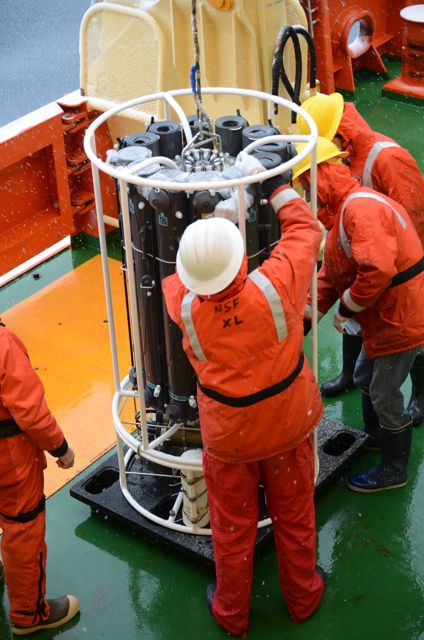
The rosette has less bottles than the main one because the CLIVAR program is mainly a physical oceanography program and not a chemical oceanography one. As a result, the trace metals group was funded to have an hour of ship time for every degree in the ocean (degree in latitude and longitude). They could have sent a rosette down at the bottom at around 4000 m, like the main rosette does at every station, only once every four stations. Instead, they decided to send it at 1000 every other station to get more spatial coverage, and also because trace elements change the most in the upper 200m. The four member team does not work in watches as a result of this schedule. They work whenever it is time for a trace metal cast, even at odd hours of the night.
Another big difference is that the main rosette is stopped at the target depth for collecting water for 30 seconds (or two ship rolls) before closing the bottle to allow the sensors in the rosette to equilibrate, and so the inside of the bottle gets 'washed' by the water. The trace metals team has a different approach. They slow down the winch as they approach to the target depth and then 'trip the bottle on the fly'. They do not stop the rosette to avoid sampling any water that comes in contact with the frame and sensors of the rosette.
Dr. Chris Measures, from the University of Hawaii, and Dr. Bill Landing, form Florida State University, pioneered this method for trace metal sampling. Most previous analysis where done by attaching single bottles at different parts of the cable and then sending by the cable a heavy plastic piece that would close them. Chris says they were not the first ones to use a rosette, but the first ones to show that the 'tripping on the fly' works well. This method reduces the amount of time required for sampling and increases the number of depths at which they can sample. A new very large program for measuring trace metals, called Geotraces, has already started based on the results that Chris and Bill have gotten on other CLIVAR cruises. The new program is designed to sample more trace metals all the way to the bottom (on this cruise they are only sampling for iron, aluminum, and manganese in every cast, and mercury in a few casts).
The differences do not stop there. The care that the trace metal teams takes so no water droplet gets into the bottles might seem paranoiac to a physical oceanographer. Once the rosette arrives from its journey through the deep water, the bottles are removed from the frame and placed on their lab, which is a container on deck instead of a lab inside the ship.
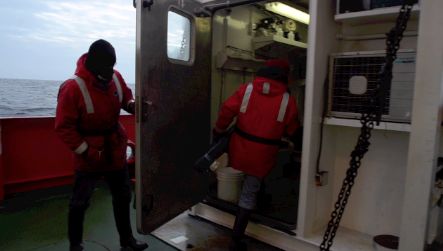
By having a van, as they call it, they are able to keep it extremely clean of dust. It has an air conditioner with a great filter that blows air in. The rosette valves and spigots are then washed with ultra clean water, and sampling begins. They first sample for salinity and nutrients to be used as reference with the main rosette's salinity and nutrients. Sometimes they sample for mercury in regular looking plastic bottles that are no regular bottles. They are designed to not react with mercury and cost $100 each.
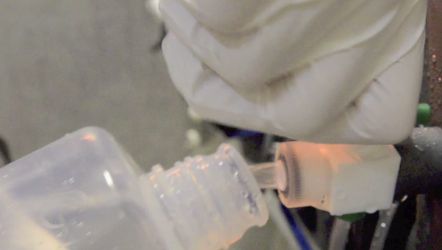
After they are done with mercury sampling they connect an air compressor to the valve of each bottle, and a filter to each spigot. The filter traps the phytoplankton and large bacteria. They collect water samples from the filtered water. This are the samples that are used for measuring the amount of trace metals dissolved in the water.
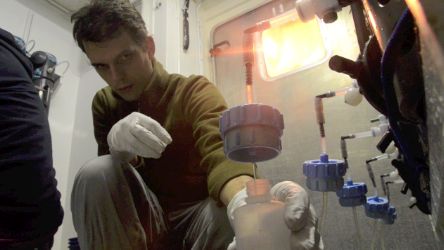
The filters will also be analyzed for measuring the trace metals in the phytoplankton and bacteria. They are removed from their filter cartridge (the blue plastic), and rinsed with distilled water and a little bit of ammonia. The ammonia is added to prevent the metals from dissolving back in the water by increasing the pH. The filters will be analyzed back on land.
I made a 25 minutes video on the whole process that I will place here once we get on land. Meanwhile, here is the four member trace metal team at the ice party. From right to left, Brian Kilgore and Dr. Bill Landing both from Florida State University; Max grand, Dr. Hugo Oliveira and Dr. Chris Measures from University of Hawaii. The hand sign some are making is a T and an M; it only works if you do it with the left hand.
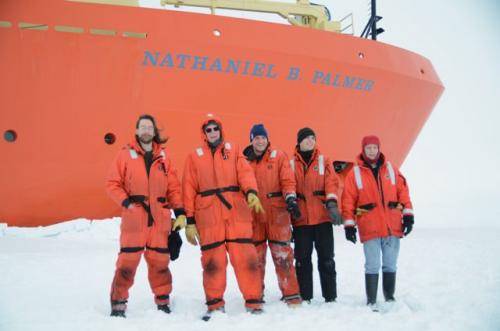
Muestro para metales traza
He estado visitando el laboratorio del grupo de metales traza y estoy listo para reportar lo que he averiguado. La forma en la que trabaja este grupo es muy diferente a la que usan los grupos que trabajan con la roseta principal. Se leíste el diario del 21 de marzo quizá te acuerdes de los siguiente sobre los metales traza.
Los metales traza son metales disueltos en el agua marina a muy baja concentración (una mil millonésima parte de una gramo en un litro de agua).
El fitoplancton, los pequeños organismos que flotan en la superficie del agua y que como las plantas terrestres obtienen energía del sol mediante la fotosíntesis, necesitan estos metales para vivir como nosotros necesitamos vitaminas.
*Hay regiones en la superficie de los océanos en las que no hay suficientes metales traza para mantener grandes cantidades de fitoplancton aún cuando hay éstas tienen suficiente luz solar y nutrientes.
- El grupo de metales traza de abordo está generando un inventario de estos metales en los océanos.
La diferencia más grande entre la roseta para medir metales traza y la roseta principal es que la primera mide propiedades de las que hay muchas fuentes alrededor de nosotros que pudieran contaminar las muestras. Casi todo en el barco está hecho de metales, al tiempo en el que queremos medir estos metales en concentraciones muy bajas.
La roseta principal no tiene fuentes cercanas de los parámetros que se miden, por lo que no hay tanto riesgo de contaminación, aún cuando se miden propiedades a concentraciones todavía más bajas que los metales traza (los CFC y SF6, por ejemplo).
La roseta está diseñada para minimizar la cantidad de metales expuestos al agua. El armazón y los pesos que hacen que la roseta se hunda están cubiertos de plástico. Se utiliza un cable oceanográfico especial hecho de kevlar, un plástico muy resistente que se usa en los chalecos antibalas, que va cubierto de nylon. Tiene cables metálicos para conducir la electricidad en su interior, pero el metal no va expuesto. El cable de la roseta principal es de acero con cables conductores en el interior. La roseta pequeña tiene algunas piezas de acero inoxidable, pero la mayor parte no tiene metal a la vista.

Las botellas en esta roseta, diseñadas bajo el mismo principio que las de la roseta principal, son diferentes. Las tapas (válvulas en este caso) se pueden mantener tapadas con plástico cuando no están en el agua. Con esto se evita que el polvo y el smog de la chimenea del barco entren a la botella. El grupo también cubre las válvulas de las botellas con guantes de plástico.
Esta roseta tiene menos botellas que la grande ya que el programa CLIVAR es un programa de oceanología física y no química. Como resultado, el programa de metales traza ha sido financiado por una hora de tiempo de barco por cada grado en latitud o longitud. Este tiempo les da para un lance de roseta hasta el fondo cada cuatro estaciones (la roseta principal se lanza en cada estación hasta el fondo). En vez de este esquema, el grupo decidió lanzar la roseta hasta 1000 m de profundidad cada dos estaciones, con lo que se aumenta la cobertura espacial. Además, la mayor variación en la concentración de los metales traza ocurre en los primeros 200m. El grupo tiene cuatro miembros, y ellos no trabajan en turnos como resultado de usar la roseta cada dos estaciones. Ellos trabajan cuando les toca, incluso en extrañas horas de la noche.
Otra gran diferencia es que la roseta principal se detiene 30 segundos (o dos vaivenes del barco) al llegar a la profundidad en la que se cerrará una botella, para permitir a los sensores que se equilibren y para que se enjuague el interior de cada botella, El grupo de metales traza usa otra técnica. Ellos disminuyen la velocidad de ascenso de la botella al llegar a la profundidad deseada y disparan la botella cuando la roseta sigue subiendo. No paran la roseta para evitar muestrear agua que haya estado en contacto con al armazón.
El Dr. Chris Measures, de la Universidad de Hawaii, y el Dr. Bill Landing, de la Universidad del Estado de Florida, son pioneros en este método para muestrear metales traza. En la mayoría de los programas anteriores, los científicos colgaban botellas en diferentes puntos del cable y las hacían cerrarse con un 'mensajero' de plástico pesado que bajaba por el cable. Chris dice que no fueron los primeros en usar la roseta para medir metales traza, pero que si fueron los primeros en demostrar que se obtienen buenos resultados al cerrar las botellas sin detener el paquete. Este método reduce el tiempo de muestreo y aumenta el número de profundidades a las que se pueden obtener muestras. Acaba de empezar un programa mundial de muestreo de metales traza, llamado Geotraces, basado en el método que desarrollaron Chris y Bill. Geotraces es más ambicioso, ya que se medirán más metales traza y se llegará hasta el fondo del mar. (en este crucero tan sólo se miden el hierro, aluminio y manganeso en cada lance de roseta, y mercurio en alguno que otro ance).
Las diferencias continúan. El cuidado con el que trabaja este grupo para que no entre en las muestras ni una gota de agua que no debe puede parecer, para un oceanólogo físco, que raya en al paranoia. Una vez que llega la roseta a cubierta tras su viaje por las grandes profundidades, la botellas se retiran del armazón y se llevan al laboratorio, que es un contenedor al que llaman van, en cubierta en vez deun laboratorio dentro del buque.

La ventaja de tener su laboratorio en el van es que pueden mantener el aire más limpio.. Tiene un aire acondicionado con un buen filtro. Las válvulas y grifos de las botellas se enjuagan con agua super destilada antes del muestreo. Primero muestrean para salinidad y nutrientes, que se usaran como referencia con los datos de la roseta principal. Algunas veces también obtienen muestras para mercurio en unas botellas de plástico de apariencia común que nada deben tener de común ya que cada una cuesta US$100. Están hechas de un plástico especial que no reacciona con el mercurio.

Después de obtener las muestras para mercurio conectan un compresor de aire a las válvulas de las botellas y un filtro en los grifos. Los filtros atrapan el fitoplancton y bacterias. Obtienen muestras de agua del agua filtrada para medir la cantidad de metales traza disueltos en el agua y también analizan los filtros para cuantificar los metales traza asimilados por el plancton y las bacterias.

Primero sacan los filtros de los cartuchos de plástico azul y luego los enjuagan con una mezcla de agua pura y un poco de amonia. Se pone amonia para reducir la acidez del agua para que no se disuelvan en el agua los metales en los organismos. Los filtros serán analizados en los laboratorios de tierra.
Hice un vídeo de 25 minutos con todo el proceso que aquí describo, y lo colgaré aquí cuando llegemosa puerto. Mientras tanto aquí les dejo al grupo de metales traza en una foto que les tomé el día del recreo. De izquierda a derecha tenemos a Brian Kilgore y al Dr. Bill Landing, ambos de Florida State University; Max grand, Dr. Hugo Oliveira y Dr. Chris Measures de la University of Hawaii. La seña que algunos están haciendo con la mano izquierda intenta ser una T M (Trace Metals). Tendrían que hacer el mismo gesto con la mano derecha para que fuera MT (metales traza).



Comments